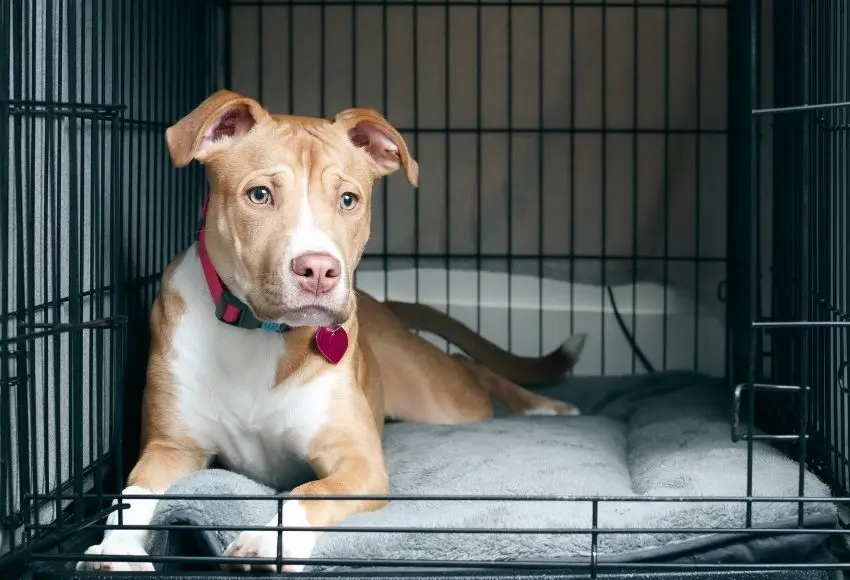Bringing a new puppy home is one of life’s purest joys. That little ball of fluff brings so much love, laughter, and… chaos. Suddenly, your clean floors are a potty-training battleground, and your favorite shoes look like a chew toy. If you’re feeling a little overwhelmed, take a deep breath. You’re not alone.
You’ve probably heard about crate training, but maybe you’re on the fence. Does it feel a bit like putting your new best friend in “puppy jail”? I get it. I really do. But what if I told you that learning how to crate train a puppy is one of the kindest, most loving things you can do for them? This guide is your ultimate resource on how to crate train a puppy successfully.
When you know how to crate train a puppy the right way, a crate isn’t a cage. It’s a safe space, a personal bedroom, and a den your puppy can call their very own. It’s a powerful tool that makes house training easier, keeps your puppy safe, and gives you invaluable peace of mind.
In this guide on how to crate train a puppy, we’ll walk you through everything, step by simple step. We’ll cover:
- Why crate training is an act of love, not punishment.
- How to pick the perfect crate (and avoid common mistakes).
- A foolproof, game-based method to make your puppy love their crate.
- Sample schedules that fit your real-life routine.
- How to conquer nighttime crying for good.
- Troubleshooting tips for the most common puppy problems.
Ready? Let’s get you and your pup on the path to success.
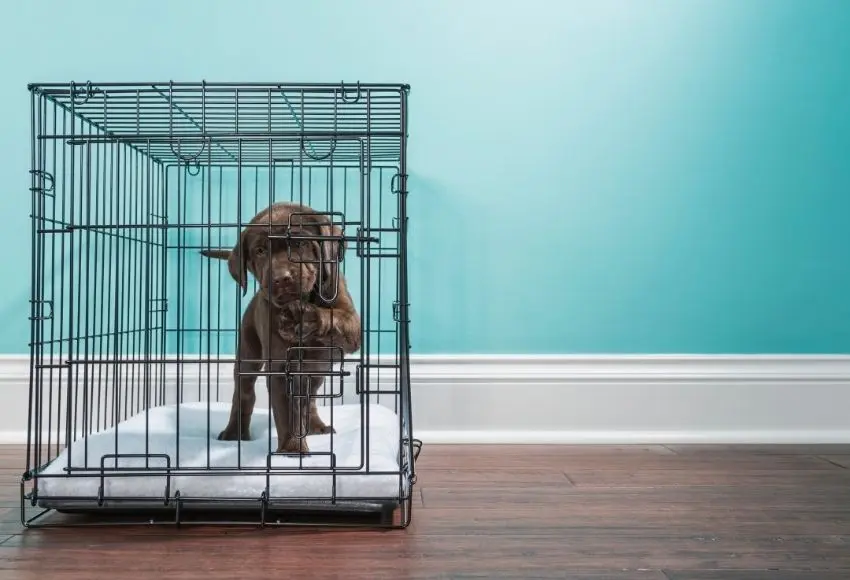
Your Puppy’s New Den: Why Crate Training is an Act of Love
First things first, let’s bust the biggest myth when learning how to crate train a puppy. It is not cruel. In fact, understanding how to kennel train a puppy taps directly into your puppy’s natural instincts. Dogs are den animals. Their wild ancestors sought out small, enclosed spaces to rest, raise their young, and feel secure. A crate mimics this den. It provides a sanctuary from the big, confusing human world.
The goal of learning how to crate train a puppy is to make them think of it as their own bedroom. It’s a place they can go to relax and feel safe when things get overwhelming, like during a thunderstorm or when you have guests over.
The benefits go way beyond just giving them a safe space. A solid foundation in how to crate train will help you with:
- House-Training: A dog’s instinct is not to soil their den. This makes the crate your number-one ally for teaching bladder control.
- Safety: When you can’t watch your puppy, the crate keeps them from chewing on electrical cords or getting into other trouble. While a crate provides a secure space, making your entire home safe is equally important. A thorough puppy proofing plan will protect them when they are exploring outside the crate.
- Travel: It’s the safest way for your dog to travel in a car and a must for most airlines and hotels.
- Peace of Mind: Knowing your puppy is safe and sound when you have to step out is priceless.
- Independence: It teaches your puppy how to be calm and comfortable when they are alone, which is a huge step in preventing separation anxiety.
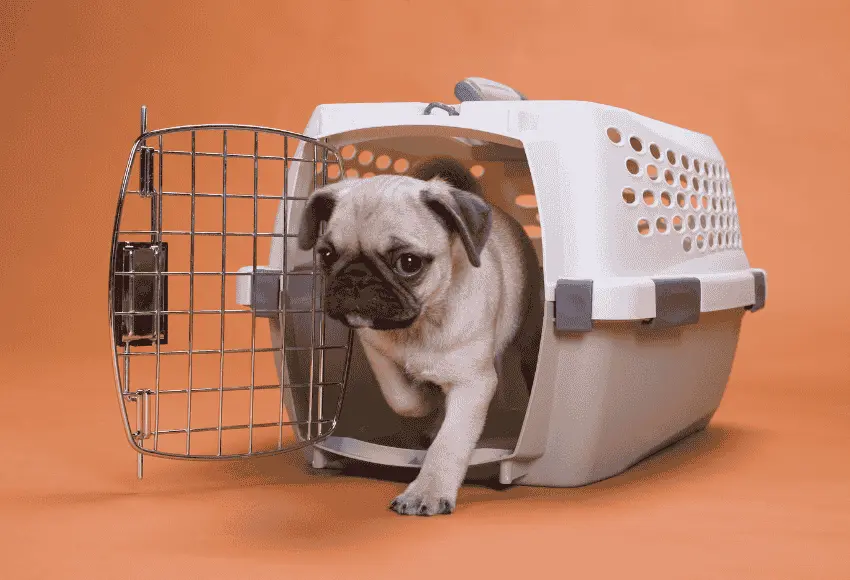
Choosing the Perfect Crate: A Buyer’s Guide
Before you start learning how to crate train a puppy, you need the right tool for the job. Your puppy’s crate is their first big piece of furniture, and getting the size right is the most important decision you’ll make. Choosing the right crate is a fundamental step in learning how to crate train a puppy.
The Goldilocks Rule: Not Too Big, Not Too Small
The biggest mistake new owners make when learning how to crate train a puppy is buying a crate that’s too large. It seems kind to give them extra room, right? But a giant crate can sabotage your house-training efforts. If there’s too much space, your puppy will often use one end as a potty and the other as a bedroom, completely defeating the purpose.
A crate that’s too small is also a problem. It will be cramped and uncomfortable, making your puppy hate it.
The crate needs to be just right. Your puppy should have enough space to comfortably stand up, turn around, and lie down in a natural position. That’s it.
How to Measure for the Perfect Fit
Don’t guess! Grab a tape measure and get these two simple measurements:
- Height: With your puppy standing, measure from the floor to the very top of their head.
- Length: Measure from the tip of their nose to the base of their tail (not the tip).
Now, just add 2 to 4 inches to both of those measurements. That gives you the ideal minimum dimensions for their crate.
The Smartest Purchase: A Crate That Grows with Your Pup
“But my puppy will get huge! Do I have to buy three different crates?”
Nope! Here’s the pro tip that will save you money and headaches: buy a crate that will fit your puppy’s full adult size, but make sure it comes with a divider.
A divider is a simple panel you can use to block off the back of the crate. This allows you to give your tiny puppy the perfect amount of space right now. As they grow, you just move the divider back until they eventually have the whole crate. It’s the most cost-effective way to approach how to crate train your puppy.
Crate Types: A Quick Breakdown
When you’re shopping for your crate training journey, you’ll see a few main types of crates. Here’s the rundown:
- Wire Crates: These are my top recommendations for most people. They have great ventilation, are easy to clean, and usually come with that all-important divider. You can toss a blanket over the top to make it feel more like a cozy den.
- Plastic Crates: These are also a great choice. They feel more naturally “den-like” and are often required for airline travel. They can be a bit harder to clean, though.
- Wood or Furniture Crates: These look beautiful and blend in with your decor. However, they are expensive, heavy, and not a good choice for puppies who like to chew.
- Fabric Crates: These are lightweight and great for travel, but only for small, calm dogs who won’t try to chew or claw their way out.
| Common Breed Examples | Typical Adult Weight | Recommended Adult Crate Size (L x W x H) | Divider Recommended? |
|---|---|---|---|
| Chihuahua, Yorkie | Up to 12 lbs | 22" x 14" x 16" | Yes |
| French Bulldog, Corgi | 13–40 lbs | 30" x 20" x 23" | Yes |
| Australian Shepherd, Bulldog | 41–70 lbs | 36" x 24" x 26" | Yes |
| Labrador, Golden Retriever | 71–90 lbs | 42" x 28" x 30" | Yes |
| German Shepherd, Rottweiler | 90+ lbs | 48" x 30" x 32" | Yes |
Note: This is a general guide. Always measure your specific dog for the best fit.
Your Step-by-Step Guide on How to Crate Train a Puppy
Okay, you’ve got the perfect crate. Now the fun begins! This section breaks down exactly how to crate train a puppy using positive, game-based methods. The secret to success is making the crate the best place on Earth. This is a game, not a chore. We’ll do this in a few simple phases.
Phase 1: The Open-Door Policy
For the first day or two, the crate is just a new piece of furniture with an open door. This initial phase is crucial for learning how to crate train without pressure.
- Set it Up: Place the crate in your living room or family room—wherever you all hang out. You want your puppy to feel like part of the family, not isolated.
- Make it Comfy: Put a soft towel or bed inside. (If your puppy is a big chewer, you might have to remove this later, but start with comfort).
- No Pressure: Prop the door open so it can’t accidentally swing shut and scare your pup. Then, just walk away. Casually toss some high-value treats (like tiny pieces of chicken or cheese) inside for them to discover on their own.
Never, ever force them in.
Phase 2: The “Crate Game”
Now we turn it into a fun, rewarding game. This is a key part of how to crate train your puppy with positive reinforcement.
- Get Excited: In a happy, upbeat voice, say something like, “Let’s play!”
- Toss and Praise: Toss a treat into the crate. When your puppy goes in to get it, shower them with praise like, “Good puppy! Yes!”.
- Introduce a Cue: As they get good at this, start saying your cue word, like “Crate!” or “Kennel up!” right as they are about to go in.
- Keep it Short: Play this game for just a few minutes at a time, several times a day.
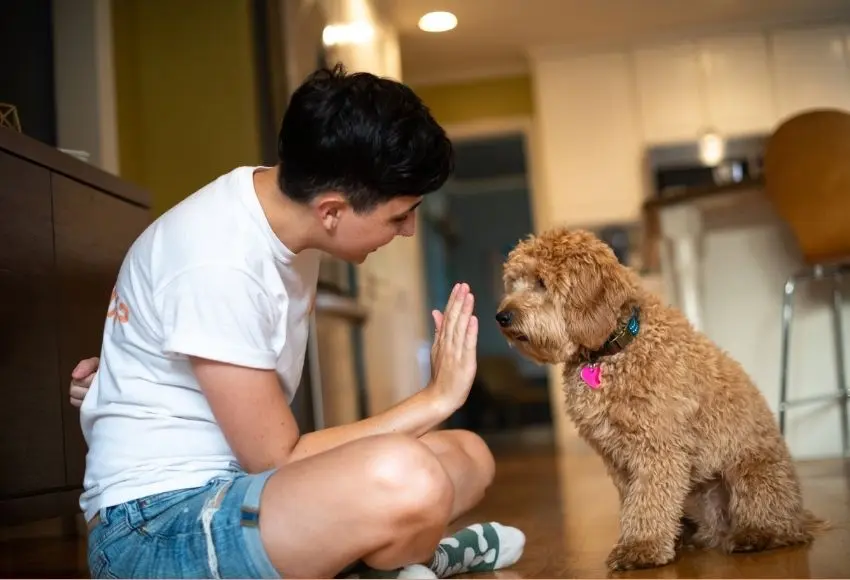
Phase 3: Dinner is Served!
This step creates a powerful positive association.
Start feeding your puppy all their meals inside the crate. At first, you might need to put the bowl right at the entrance. As they get more comfortable, gradually move the bowl to the very back of the crate so they have to step all the way inside to eat.
Phase 4: Closing the Door (Briefly!)
This is a big step, so we take it slow.
- Close and Open: Once your pup is happily eating in the crate, gently close the door while they eat. The moment they finish their last bite, open the door.
- Add a Few Seconds: Gradually start leaving the door closed for a few seconds after they finish eating.
- Mix It Up: This is key. Don’t just make the time longer and longer. Vary it! Close it for 5 seconds, then 2 seconds, then 10 seconds, then 3 seconds. This prevents your puppy from getting anxious about the time increase and keeps them relaxed.
Creating a Daily Crate Training Schedule
Puppies thrive on routine. A predictable crate training schedule helps them understand when it’s time to play, eat, potty, and rest. Following a consistent crate training schedule is the secret to fast and effective house training.
A good rule of thumb for how long a puppy can “hold it” is their age in months plus one. So, a 2-month-old puppy can generally hold it for about 3 hours at most. Remember, young puppies under 6 months should not be left in a crate for more than 3-4 hours at a time during the day.
Here is a sample schedule. Adjust the times to fit your life! The pattern is what matters: Potty -> Play/Eat -> Crate/Nap -> Repeat.
| Time | Activity for a Work-From-Home Parent | Activity for a 9-to-5 Commuter |
|---|---|---|
| 7:00 AM | Wake up & an immediate potty break. | Wake up & an immediate potty break. |
| 7:30 AM | Breakfast (in the crate!), followed by another potty break. | Breakfast (in the crate!), followed by another potty break. |
| 8:00 AM | Crate time for a nap while you start work. | Crate time while you get ready and leave for work. |
| 10:00 AM | Potty break, then 30 minutes of supervised playtime/training. | This is when a dog walker or friend MUST visit. |
| 10:30 AM | Back in the crate for another nap. | Potty break, playtime, then back in the crate. |
| 12:30 PM | Potty break, lunch, and some more playtime. | This is when you or a dog walker MUST visit for lunch. |
| 1:30 PM | Create time for an afternoon nap. | Potty break, playtime, then back in the crate. |
| 4:00 PM | Potty break and free time (supervised). | Dog walker visits for a final potty break. |
| 5:30 PM | Potty break, dinner (in a crate), and family playtime. | You arrive home! Immediate potty break, then dinner & play. |
| 8:00 PM | Quiet time, winding down. | Quiet time, winding down. |
| 10:00 PM | Final potty break, then into the crate for the night. | Final potty break, then into the crate for the night. |
This structure is a game-changer for anyone learning how to crate-train a puppy.
How to Crate Train a Puppy at Night
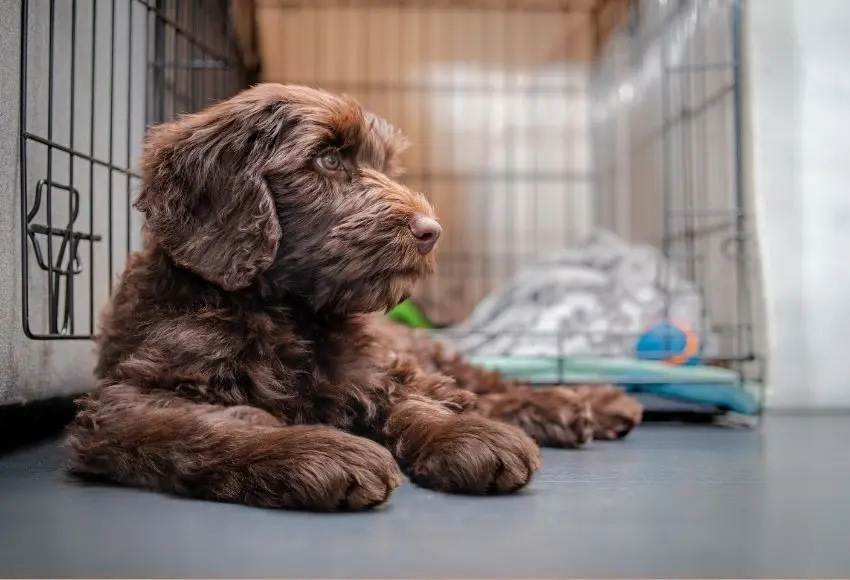
Nighttime can be the toughest part. Your puppy is alone for the first time, and it can be scary for them and sleepless for you. Many new owners find that figuring out how to crate train a puppy at night is their biggest challenge, but it doesn’t have to be. Here’s how to crate train a puppy at night and get some rest.
Is it a demand for attention? If they are just whining or barking to get out, you must ignore it (as long as you are sure their needs are met). Wait for a moment of quiet—even just one second—before you ever open the door. This teaches them that crying gets them nothing, but being quiet gets them everything.
Put the Crate in Your Bedroom. This is non-negotiable for the first few weeks. Your puppy has just left their mom and littermates. Being able to hear, smell, and see you is incredibly comforting and reduces anxiety. It also lets you hear them if they genuinely need to go potty.
Create a Bedtime Routine. Dogs love routines. About an hour before bed, start a wind-down process.
Wear them out with some gentle play, but don’t get them all riled up.
Remove food and water about 1-2 hours before bed to minimize midnight potty needs.
Take one last potty break. Make it quick and boring—this is for business only.
Handle Midnight Cries Calmly. If your puppy starts crying, you need to figure out why.
Is it a potty emergency? If it’s been a few hours and the cry sounds urgent, they probably need to go out. Keep the lights low and don’t talk or play. Carry them out, let them do their business, give quiet praise, and put them right back in the crate.
Troubleshooting: When Things Get Tricky
Even when you know how to crate train a puppy, you might face some hurdles. Here’s how to solve the most common problems.
The Big “Don’ts” of Crate Training
These are the absolute ‘don’ts’ when you’re learning how to crate train.
- NEVER use the crate as punishment.
- NEVER leave your puppy in the crate for too long.
- NEVER let children or other pets bother the puppy in their crate. It’s their safe space.
- NEVER bang on or yell at the crate. This only creates fear.
Help! My Puppy is Crying and Won’t Stop!
This is where you need to be a detective. There is a huge difference between a puppy who is annoyed and a puppy who is in a true panic.
True Panic: This is genuine terror. The signs are frantic scratching or digging at the door, non-stop screaming, heavy drooling, or even hurting themselves. Do not let a panicked puppy “cry it out.” This will create a deep-seated phobia. Calmly let them out, soothe them without a big fuss, and realize you’ve moved too fast. You need to go back to the beginning of the crate games and build more positive associations and realize you’ve moved too fast. You need to go back to the beginning of the crate games and build more positive associations.
Annoyed Whining: This is a learning behavior. The puppy is testing you. It might be a rhythmic whine or a demanding bark. The correct response is to ignore it and wait for quiet.
Help! My Puppy Chews Their Bedding!
This is common, especially with teething puppies. The solution is simple: take the bedding out. A hard surface is much safer than an expensive vet bill for an intestinal blockage. Give them a safe, durable chew toy like a frozen Kong to work on instead.
Help! My Puppy Had an Accident in the Crate!
This almost always means one of three things:
- The crate is too big.
- They were left in for too long.
- There might be a medical issue like a UTI (consult your vet).
When you clean it up, use an enzymatic cleaner (available at any pet store). Regular cleaners won’t eliminate the smell, which tells your puppy it’s okay to go there again.
The Finish Line: A Lifetime of Confidence
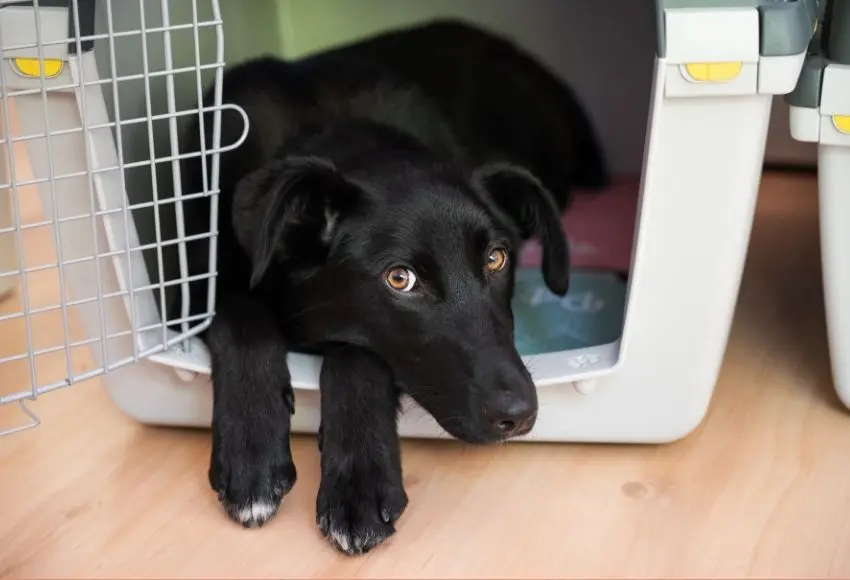
Learning how to crate train a puppy takes patience, consistency, and a lot of love. There will be good days and tough nights. But by following these steps, you are giving your puppy an incredible gift: a personal sanctuary where they will always feel safe and secure.
Stick with it. Celebrate the small wins. Before you know it, you’ll see your puppy trot into their crate on their own for a nap, and you’ll know you’ve given them a foundation of confidence that will last a lifetime. You now have all the tools you need for how to crate train a puppy and build a bond of trust that will last forever. You’ve got this!
“Here at PawGearHub, we are dedicated to helping you and your new best friend navigate every step of your journey together. Explore more of our expert guides for a happy, healthy pup.”

